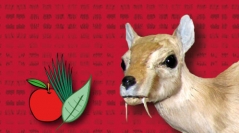

 Geodiversitas
41 (10) - Pages 385-399
Geodiversitas
41 (10) - Pages 385-399This study reveals the oldest fruit enriched diet in Moschidae so far. It deals with tooth meso- and microwear of Micromeryx flourensianus Lartet, 1851 and M.? eiselei Aiglstorfer, Costeur, Mennecart & Heizmann, 2017 from the two fossil-rich middle Miocene localities, Sansan (France, 14.1 Ma) and Steinheim am Albuch (a. A., Germany, 13.5 Ma). In combination with literature data it indicates different levels of frugivory in moschids during the Miocene and suggests ecologic niche partitioning of two sympatric moschids in Steinheim a. A. The Miocene data imply a dietary shift during the evolution of the family, as feeding on fruits and/or nuts is not common in modern Moschidae. A direct comparison of the results for Sansan and Steinheim a. A. points to a slightly more abrasive diet in Steinheim a. A. and thus assumedly more arid conditions. Differences are only minor, however, and indicate that Sansan was most likely already affected as well by the middle Miocene cooling phase.
Micromeryx, microwear, mesowear, sympatry, Middle Miocene cooling, Miocene Climatic Event, Steinheim am Albuch, Sansan